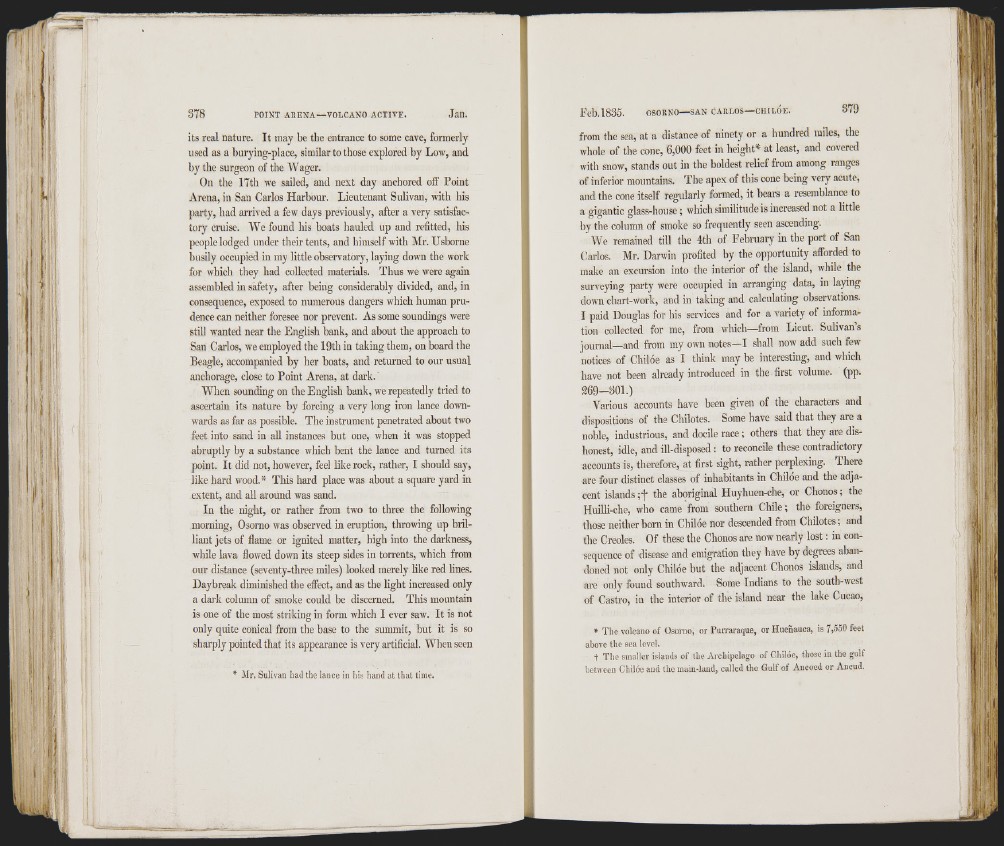
,1 I I
1’1 «I wfit
its real nature. I t may be the entrance to some cave, formerly
used as a burying-place, similar to those explored by Low, and
by the surgeon of the Wager.
On the 17th we sailed, and next day anchored off Point
Arena, in San Carlos Harhour. Lieutenant Sulivan, with his
party, had arrived a few days previously, after a very satisfactory
cruise. AVe found his boats hauled up and refitted, his
people lodged under their tents, and himself with Mr. Usborne
busily occupied in my little observatory, laying down the work
for which they had collected materials. Thus we were again
assembled in safety, after being considerably divided, and, in
consequence, exposed to numerous dangers which human prudence
can neither foresee nor prevent. As some soundings were
still wanted near the Lnglish bank, and about the approach to
San Carlos, we employed the 19th in taking them, on board the
Beagle, accompanied by her boats, and returned to our usual
anchorage, close to Point Arena, at dark.
When sounding on the Lnglish bank, we repeatedly tried to
ascertain its nature by forcing a very long iron lance downwards
as far as possible. The instrument penetrated ahout two
feet into sand in aU instances but one, when it was stopped
abruptly by a substance which bent the lance and turned its
point. It did not, however, feel like rock, rather, I should say,
like hard wood. * This hard place was about a square yard in
extent, and all around was sand.
In the night, or rather from two to three the following
morning, Osorno was observed in eruption, throwing up brilliant
jets of flame or ignited matter, high into the darkness,
while lava flowed down its steep sides in torrents, which from
our distance (seventy-three miles) looked merely hke red lines.
Daybreak diminished the effect, and as the light increased only
a dark column of smoke could be discerned. This mountain
is one of the most striking in form which I ever saw. I t is not
only quite conical from the base to the summit, but it is so
sharply pointed that its appearance is very artificial. When seen
* Mr. Sulivan had the lance in his hand at that time.
from the sea, at a distance of ninety or a hundred miles, the
whole of the cone, 6,000 feet in height* at least, and covered
with snow, stands out in the boldest relief from among ranges
of inferior mountains. The apex of this cone being very acute,
and the cone itself regularly formed, it bears a resemblance to
a gigantic glass-house ; which similitude is increased not a little
by the column of smoke so frequently seen ascending.
We remained till the 4th of February in the port of San
Carlos. Mr. Darwin profited by the opportunity afforded to
make an excursion into the interior of the island, while the
surveying party were occupied in arranging data, in laying
down chart-work, and in taking and calculating observations.
I paid Douglas for his services and for a variety of information
collected for me, from which—from Lieut. Sulivan’s
journal—and from my own notes—I shall now add such few
notices of Chilóe as I think may be interesting, and which
have not been already introduced in the first volume, (pp.
369—301.)
Various accounts have been given of the characters and
dispositions of the Chilotes. Some have said that they are a
noble, industrious, and docile race ; others that they are dishonest,
idle, and ill-disposed : to reconcile these contradictory
accounts is, therefore, at first sight, rather perplexing. There
are four distinct classes of inhabitants in Childe and the adjacent
islands ; f the aboriginal Huyhuen-che, or Chonos; the
Huilli-che, who came from southern Chile; the foreigners,
those neither horn in Chilóe nor descended from Chilotes; and
the Creoles. Of these the Chonos are now nearly lost: in consequence
of disease and emigration they have by degrees abandoned
not only Chilóe but the adjacent Chonos islands, and
are only found southward. Some Indians to the south-west
of Castro, in the interior of the island near the lake Cucao,
• The volcano of Üsorno, or Purraraque, or Huenauca, is 7,550 feet
above the sea level.
t The sm uller islands of the Archipelag-o of Cliilóe, those in the gulf
hetAvecn Chiloe and the main-land, called the Guli of Ancocd or Ancud.
fl